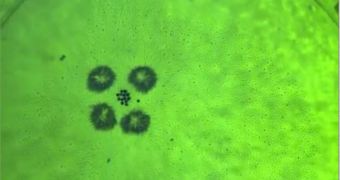Physicists with the US Department of Energy's (DOE) Argonne National Laboratory (ANL) announce that they were recently able to develop a series of micro-robots that are capable of assembling themselves into more complex structures.
The small devices have a diameter of just 500 microns, or about half a millimeter, and are made up of very tiny minuscule ferromagnetic particles. The robotic system is placed in buoyancy between layers of water and oil, and is controlled externally using a magnet.
Ferromagnetic materials distinguish themselves through the fact they exhibit the strongest level of magnetic interactions of all materials known to date. In this particular case, they are controlled using an alternating magnetic field, perpendicular to the mixture.
When exposed to these fields, the particles assemble themselves in spiked circle-like formations called asters, which can then be made to move using a magnetic field oriented parallel to the mixture.
“We can make them open their jaws and close them. This gives us the opportunity to use these creatures as mini-robots performing useful tasks. You can move them around and pick up and drop objects,” ANL physicist and team leader Alexey Snezhko explains
While observing the behavior these micro-robots displayed, the team noticed that two different types of asters formed, one that favored inward flow, and another that favored outward flow. Snezhko and colleague Igor Aronson realized immediately that the two flavors could work together.
When the two types of flows are pitted against each other, then asters can come together to perform even more complex tasks, such as for example acting like vacuum cleaners that remove particles from the solution in which they themselves are suspended.
Furthermore, the team also demonstrated that it's possible to use the cluster to grapple larger objects, such as for example a glass bead more than four times larger than the asters.
“They can exert very small forces on objects, which is a big challenge for robotics. Gripping fragile objects without smashing them has always been difficult for conventional robots,” Aronson explains.
“You can grab microparticles with lasers, but the force is much smaller. These asters' forces are more powerful, but they can handle items much more delicately than mechanical micromanipulators can,” Snezhko concludes.

 14 DAY TRIAL //
14 DAY TRIAL //